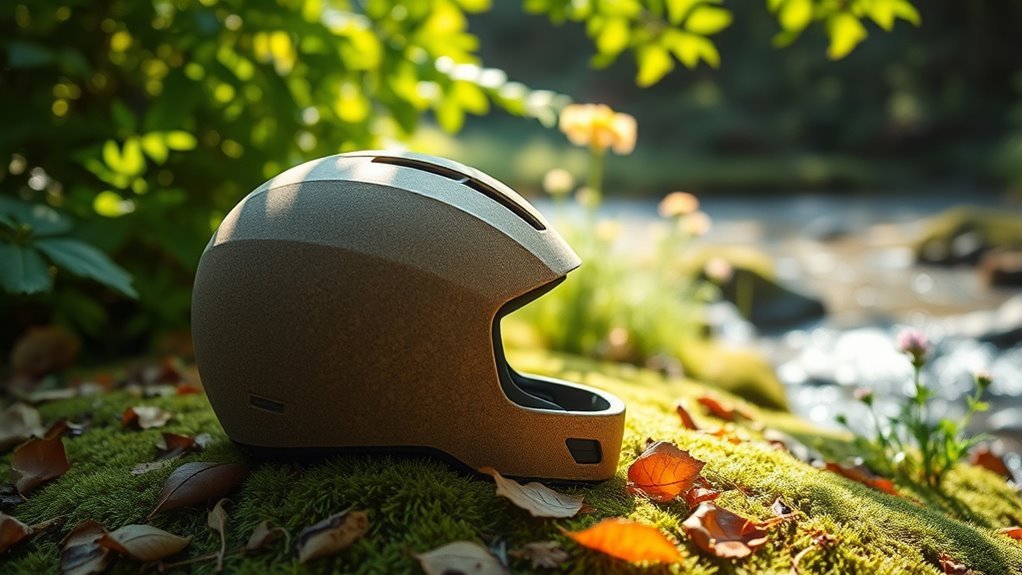Biodegradable Helmets: Fact or Fiction?
Biodegradable helmets are more than just a buzzword; they’re an innovative response to environmental concerns. These helmets use eco-friendly materials that break down naturally, reducing landfill waste. However, while they promote sustainability, some may question their durability compared to traditional options. It’s crucial to balance safety and eco-friendliness when choosing your gear. If you’re curious about how these helmets stack up in performance and impact, there’s more to discover about their safety features and market trends.
Understanding Biodegradable Materials

As you explore the world of biodegradable materials, it’s essential to grasp what makes them distinct from traditional options. Biodegradable polymers break down naturally through material decomposition, offering a more sustainable alternative to synthetic materials that linger in landfills. Unlike conventional plastics, which can take centuries to degrade, these innovative substances decompose into harmless byproducts when exposed to the right environmental conditions. This transformation not only reduces waste but also minimizes pollution, freeing up the planet from harmful residues. Understanding these differences empowers you to make informed choices, aligning your values with your purchasing decisions. Embracing biodegradable options can lead to a more sustainable lifestyle, allowing you to contribute to a healthier planet while enjoying the freedom of conscious consumerism.
The Science Behind Helmet Safety

While you might think of helmets as simple protective gear, the science behind their safety is both complex and fascinating. Helmets are engineered to excel in impact absorption, utilizing advanced materials designed to dissipate energy during a collision. When you wear a helmet, its outer shell spreads the force of impact, while the inner foam layers compress to absorb energy, protecting your head from injury. Material resilience is essential here; high-quality materials can withstand repeated impacts without losing their protective properties. This means your helmet remains effective over time, ensuring your safety during those exhilarating rides. Understanding these principles can empower you to choose the best helmet, ultimately allowing you to enjoy your adventures with confidence and peace of mind.
Comparing Biodegradable Helmets to Traditional Options

When it comes to choosing a helmet, you might find yourself weighing the benefits of biodegradable options against traditional ones. Biodegradable innovations promise a more sustainable future, but how do they stack up regarding helmet durability? Traditional helmets often boast superior strength and longevity, crafted from materials designed to withstand impacts over time. In contrast, biodegradable helmets may sacrifice some durability for eco-friendliness, raising questions about their lifespan and protective capabilities. If you value sustainability, biodegradable options might appeal to your sense of freedom, allowing you to make environmentally conscious choices. However, if safety and durability are your top priorities, traditional helmets could be the way to go. Ultimately, it’s about finding the right balance for your needs.
Environmental Impact of Biodegradable Helmets
Understanding the environmental impact of biodegradable helmets reveals a significant shift towards sustainability in protective gear. These helmets not only protect your head but also offer numerous biodegradable benefits that contribute to environmental sustainability. Here’s what you should consider:
- Reduced landfill waste: Biodegradable materials decompose naturally, minimizing waste.
- Lower carbon footprint: Production often requires less energy than traditional helmets.
- Non-toxic materials: Many use plant-based substances, decreasing harmful emissions.
- Encourages eco-conscious choices: Consumers are more likely to support brands that prioritize the environment.
- Potential for innovation: Advances in biodegradable technology could lead to even better designs.
Consumer Perspectives and Market Trends
As consumers become more eco-conscious, the demand for helmets made from sustainable materials is on the rise. This shift is influencing pricing strategies and affordability, prompting manufacturers to innovate while keeping costs competitive. Understanding these trends is essential for anyone looking to navigate the evolving market of biodegradable helmets.
Eco-Friendly Materials Demand
The growing demand for eco-friendly materials is reshaping consumer behavior and market dynamics in unprecedented ways. You’re increasingly aware of the environmental impact of your choices, driving a shift toward sustainable products. This change reflects in trends such as:
- Preference for helmets made from recycled plastics
- Interest in organic fibers for comfort and sustainability
- A desire for transparency in manufacturing processes
- Stronger support for brands with eco-friendly practices
- Growing awareness of the lifecycle of products
As you seek freedom through responsible consumption, the use of biodegradable materials in helmets becomes more than a trend; it’s a movement. By choosing sustainable options, you’re not just protecting yourself but also contributing to a healthier planet.
Pricing and Affordability Trends
While many consumers are enthusiastic to embrace biodegradable helmets, pricing and affordability remain significant considerations in their purchasing decisions. Cost analysis reveals that these eco-friendly options often come with a higher price tag than traditional helmets, which can deter potential buyers. However, with increasing market competition, brands are beginning to offer more affordable alternatives, making biodegradable helmets accessible to a wider audience. As consumers weigh their options, they’ll likely consider not just the initial cost but also the long-term benefits of sustainability. Ultimately, as the demand for green products grows, prices may become more competitive, aligning with your desire for freedom to choose environmentally responsible gear without breaking the bank.
The Future of Sustainable Cycling Gear
Cycling gear is evolving rapidly, and with the increasing demand for eco-friendly alternatives, sustainable options are becoming more accessible than ever. As you embrace these cycling trends, you’ll notice exciting sustainable innovations transforming your ride. Here are some emerging options to evaluate:
- Biodegradable helmets: Designed to break down without harming the environment.
- Recycled materials: Apparel made from repurposed plastics and fabrics.
- Solar-powered gadgets: Charging devices on-the-go with renewable energy.
- Eco-friendly tires: Made from sustainable rubber, reducing your carbon footprint.
- Sustainable accessories: Bags and gear crafted from organic materials.
These advancements not only enhance your cycling experience but also contribute to a healthier planet. By choosing sustainable gear, you’re riding toward a greener future.
Frequently Asked Questions
How Long Do Biodegradable Helmets Take to Decompose in Various Environments?
Biodegradable helmets typically take anywhere from a few months to several years to decompose, depending on environmental conditions. In composting environments rich in moisture and microorganisms, decomposition rates accelerate, while in dry or cold settings, they slow down markedly. Understanding these rates is essential for evaluating their overall environmental impact, as faster decomposition means less landfill waste and a reduced carbon footprint. You’ll want to take these factors into account when making eco-friendly choices.
Are There Any Safety Certifications for Biodegradable Helmets?
When it comes to safety, biodegradable helmets aren’t just a green dream; they also need to meet strict safety standards. While some manufacturers seek certification, not all biodegradable helmets have gone through the rigorous certification processes that traditional helmets do. It’s essential for you to check if a helmet has been certified by recognized organizations, ensuring it offers the protection you need while also aligning with your values of sustainability.
Can Biodegradable Helmets Be Recycled After Use?
Yes, biodegradable helmets can be recycled, but it depends on the materials used. Traditional recycling processes might not accept them, as they often require specialized waste management systems. If you’re looking to dispose of one, check for local programs that handle biodegradable products. By doing so, you contribute to a more sustainable waste management approach, ensuring that materials are processed effectively rather than ending up in landfills. Your choices can make a difference!
What Materials Are Typically Used in Biodegradable Helmets?
Biodegradable helmets often use natural fibers like hemp, flax, or jute, combined with sustainable alternatives such as plant-based resins. These materials not only provide adequate protection but also break down more easily than traditional plastics. You’ll find that these eco-friendly options cater to your desire for sustainability while ensuring safety. Embracing such innovations can empower you to make choices that benefit both your well-being and the environment, merging protection with a greener future.
Are Biodegradable Helmets More Expensive Than Traditional Helmets?
Yes, biodegradable helmets can be more expensive than traditional ones, primarily due to the cost of sustainable materials and production processes. When you look at cost comparison, market trends indicate that as demand for eco-friendly products rises, prices may stabilize. However, the initial investment might be higher. You’re also investing in the planet’s future, which could align with your values, making it a worthwhile consideration despite the upfront costs.






